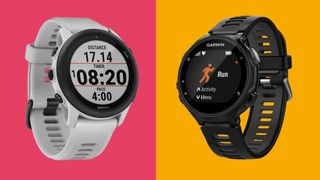
Garmin has finally released an update for its venerable triathlon watch, the Garmin Forerunner 735XT, which made its debut back in 2016. The new Garmin Forerunner 745 is packed with some very useful extra fitness functions as well as smartwatch features, but does that justify its higher price tag?
Here we've compared the key features of both Garmin watches so you can make an informed decision and choose which is the right one for you.
Price
As a newer, more powerful fitness tracker, it's not surprising that the Forerunner 745 is by far the more expensive of the two.
At the time of writing, the Garmin Forerunner 735XT is listed on Garmin's site for $359.99 / £299.99 / AU$599, though it can be found more cheaply at third-party retailers. Meanwhile, the Garmin Forerunner 745 is listed at $499.99 / £449.99 / AU$849.
The price of the 735XT might drop even lower now that it's been superseded. If you're thinking of making a purchase but aren't in a rush, it may be worth waiting until Black Friday 2020, when there's a good chance that some retailers will offer the older watch at a discounted price as they work on clearing their stock.
Design and display
The Garmin Forerunner 735XT measures 44.5 x 44.5 x 11.9mm, while the Forerunner 745 measures 43.8 x 43.8 x 13.3mm, making its case slightly smaller in diameter but a little thicker. The 735XT weighs 44g, while the 745 tips the scales at a heftier 47g.
The two watches share a similar design, with a circular face and memory-in-pixel display, but the Forerunner 745 has a higher resolution (240 x 240 pixels compared to 215 x 180), resulting in a crisper image.
Get daily insight, inspiration and deals in your inbox
Get the hottest deals available in your inbox plus news, reviews, opinion, analysis and more from the TechRadar team.
Both devices are water resistant to 5ATM, making them suitable for wearing in the pool, sea and shower.
Smartwatch features
The Garmin Forerunner 745 has a lot of smartwatch features that the 735XT is lacking, including Garmin Pay for making contactless payments, a music player (with storage for up to 500 songs), and the ability to reject phone calls and send a text response (on Android only).
Both devices feature a stopwatch, alarm clock and sunrise/sunset times, but the Forerunner 745 also includes a timer (handy if you're aiming to hit a certain target when holding a plank, for example).
Both include GPS and GLONASS for location tracking, but the Forerunner 745 supplements this with the Galileo navigation system. The 745 also includes a barimetric altimeter for accurately measuring your altitude, plus a thermometer and gyroscope. Both watches have a compass and accelerometer.
Health monitoring
Whichever watch you choose, you'll get all the usual health tracking functions, including a step tracker, 'move' notifications if you stay still for too long, and a record of floors climbed, distance covered and calories burned. Both watches will also record 'intensity minutes', which is an easy way of seeing how long you've spent in different heart rate zones.
Both the Forerunner 735XT and Forerunner 745 include continuous heart rate tracking, and provide a report on your daily resting heart rate, but the Forerunner 745 also gives you an alert if it detects an abnormal resting heart rate.
Another key difference between the two watches is that the Forerunner 745 features a pulse-ox sensor to monitor blood oxygen saturation. You can perform a spot-check on this at any time, and the watch can also monitor it throughout the day and at night (though doing so will drain the battery more quickly).
Fitness tracking
As multi-sports watches, both the Garmin Forerunner 735XT and Forerunner 745 offer a wealth of activity tracking options for running, cycling, swimming and more. The 745 is easily the more capable of the two though, and may offer some features you'll find particularly useful in your training.
For example, the addition of a thermometer and altimeter means the newer watch can offer heat and altitude acclimation, helping you more accurately gauge how hard you're working in tough conditions, and build your fitness accordingly.
Like recent sports watches from Coros and Polar, the Forerunner 745 can also calculate your current training load, plus your training status so you can see how effectively you're working based on your training level and fitness trend.
Excitingly for runners and cyclists, the Forerunner 745 also supports Strava Live Segments, as well as the similar Garmin Live Segments, letting you see how you measure up right on your wrist.
There are some more features for swimmers as well, including underwater heart rate monitoring from your wrist (the 735XT needed a connected chest-strap heart rate monitor to take your pulse in the pool), auto-rest, and time and distance alerts.
Battery life
The Garmin Forerunner's 745's more advanced feature set means its battery will drain more quickly than that of the 735XT.
You can expect the Forerunner 735XT to last up to 11 days in smartwatch mode, and up to 14 hours in GPS mode. It will keep going for up to 24 hours in UltraTrac mode, which turns off GPS periodically to save power.
The Garmin Forerunner 745 has a battery life of up to seven days in smartwatch mode, up to 16 hours in GPS mode, and up to six hours in GPS mode with music. You can expect it to last up to 21 hours in UltraTrac mode.
- Our complete guide to the best running watches
Cat is the editor of TechRadar's sister site Advnture. She’s a UK Athletics qualified run leader, and in her spare time enjoys nothing more than lacing up her shoes and hitting the roads and trails (the muddier, the better)
Most Popular

